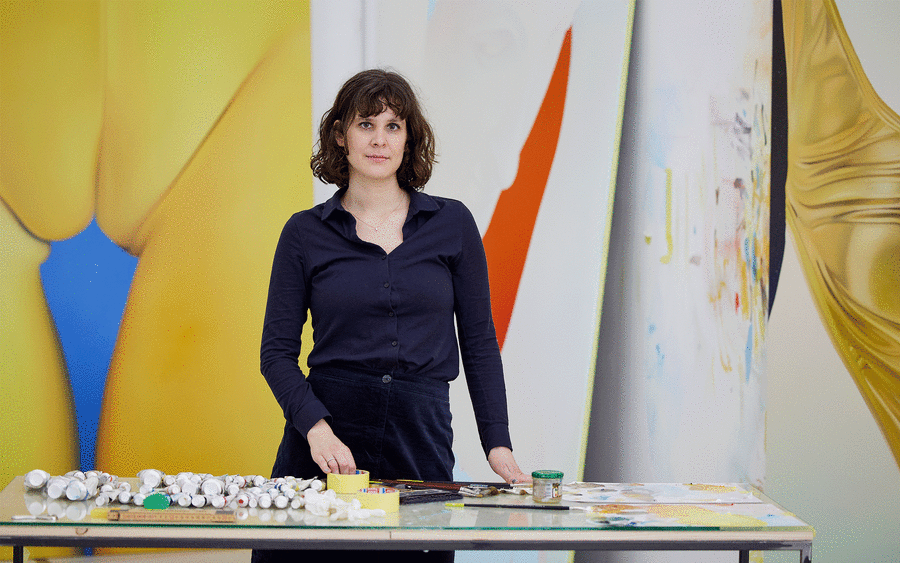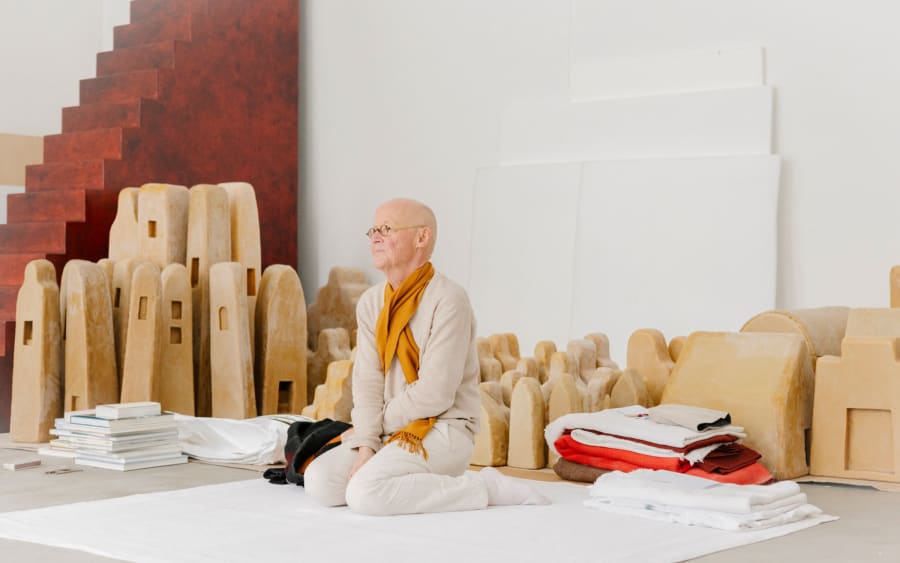It is said that when Pandora’s box was opened, Zeus looked to earth from his abode on Mount Olympus and saw wars, bloodshed, carnage, and unrest. Horrified, the king of the ancient Greek gods flew into a fit of rage and vowed to destroy humanity for its corruption. And so, he commanded a deluge. ‘When mankind got to that level of power-worship and dictatorship, Zeus created the flood to erase it,’ says Egyptian artist Wael Shawky when describing his film, I Am the Hymns of the New Temple (2023).
The work, Shawky’s first venture with Greek mythology, debuted last May at the Archaeological Park of Pompeii and was the first artwork to be created as part of ‘Pompeii Commitment. Archaeological Matters’ (PCAM). PCAM, a program conceived by the Italian Ministry of Culture and the Archaeological Park of Pompeii, was established to propose fresh takes on the ancient city. Shawky was initially approached by the art historian Andrea Viliani, currently the director of Rome’s Museo delle Civiltà and back then, head of the research center at Castello di Rivoli. Shawky visited Pompeii in 2020; he was then put up in an apartment right next to the ancient city, where for 6 weeks in 2022, he shot I Am the Hymns of the New Temple.
In the approximately 1-hour-long film narrated in Arabic, Shawky explores the propagation of Greek myths, focusing on how, when, and where they were shared. ‘I always try to read history based on what the sources are telling us, even if I don’t believe it,’ he tells Art Basel. ‘I find that putting forth things as is, is a sort of critique and analysis in and of itself.’ The lines of history and myth become blurred in I Am the Hymns of the New Temple. Set in a place covered in the volcanic ash of Mount Vesuvius, it showcases Pompeii as both a theater and archaeological site – one that stands as testament to many other faiths (the Temple of Isis, for example, a Roman sanctuary dedicated to an Egyptian goddess, is on view in the film). There are no puppets here – a narrative device often used by Shawky in his work – but real-life actors who wear luxurious ancient silks as well as masks designed by the artist and made by a team of professional ceramicists in Aubagne, France, headed by Pierre Architta, who had created over 250 ceramic marionettes for Shawky’s Cabaret Crusades: The Path to Cairo in 2013.
In September 2023, 5 months after the film was shown in Pompeii, Shawky was invited by the Egyptian government to represent his country at the Venice Biennale. After lots of deliberations with his galleries (Lisson Gallery, Sfeir-Semler Gallery, Lia Rumma, and Barakat Contemporary) the Alexandria-born artist agreed on condition that he was given ‘full control of the pavilion and no interference on concept or anything at all.
Like many others, Shawky felt hopeful after the 2011 Egyptian revolution. ‘We thought there would be change, but the revolution failed completely,’ says the artist, who has not exhibited in his home country in 13 years. Representing Egypt was a decision, he says, ‘to have a voice rather than having nothing.’ It was almost a no-brainer to show I Am the Hymns of the New Temple at the Egypt Pavilion. The galleries concurred – after all, it was not exhibited in a museum or in a magnanimous cultural platform; the Egyptian government had already given Shawky carte blanche; the Italian government was elated to show a ‘native’ creation at the Olympics of the art world; and then of course there was the challenge of time, with the Egyptian government’s 11th-hour invitation. ‘Perhaps I could make extra work alongside the film,’ Shawky recalls of the initial proposal.
But something gnawed at him. His hesitation grew and could not be silenced. After discussions with Carolyn Christov-Bakargiev, the director of Castello di Rivoli Museo d'Arte Contemporanea, who encouraged Shawky to do something else, he changed course in November. Nevertheless, the Italian government was relieved with the staging of I Am the Hymns of the New Temple at Venice’s Museo Palazzo Grimani, opening on April 17.
By the time he had shifted the pavilion’s focus, the war in Gaza was underway and Shawky – ever the repository of ideas yet to be realized – refined the concept of a film, which echoed the catastrophic events unfolding. ‘It’s political and historical and wholly reflective of what is happening in the world today,’ he says of the film, which explores Egyptian history vis-à-vis the British Empire.
The specter of Gaza hung over this film from the start. ‘It also focuses on my hometown of Alexandria and its bombardment, which echoes the bombardment of Gaza. We don’t mention Gaza, but no doubt people will connect it to what is happening today,’ says Shawky, who is working day and night to meet the Biennale deadline. ‘I’m so proud of this film.’
He likens himself to a translator, one who takes a creative form, such as text or a story, and reinterprets it as visual art. ‘This kind of process makes me feel free and I enjoy it all the more when I am working with history. I find it fascinating,’ he says. ‘It gets you to analyze the story – when the gap between fact and myth is big enough to be creative.’
There will not just be a film in Shawky’s pavilion. Audiences will also be able to see objects from the film’s scenography and perhaps some drawings and paintings. ‘Many things are under construction. I’m creating a world here,’ he says. ‘It’s how to use different types of media given that each has its own limitations and dimensions. You can make things in drawings that you can’t make in film; sculptures can never become drawings for example.’
In the pavilion, audiences will sample Shawky’s trademark talent for illuminating the various aspects of historical events. His works have, for years, consistently unraveled stories, both untold and told; those very same stories that we believe to be true as well as those we question all at once. In short, Shawky practices being suggestive. It is a realm he is most comfortable in. ‘The more accurate you are, the more analytical, rather than cynical, you become,’ he states. ‘Of course, we will never know the truth, and it’s imperative that we ask: who is telling the story of what?’
Wael Shawky is represented by Lisson Gallery (London, Los Angeles, New York, Shanghai), Sfeir-Semler Gallery (Beirut, Hamburg), Lia Rumma (Milan, Naples), and Barakat Contemporary (Seoul).
Myrna Ayad is a Dubai-based arts consultant, cultural strategist, and editor, and is recognised as one of the Middle East's leading cultural commentators.
Caption for top image: Wael Shawky, Untitled (detail), 2023. Courtesy of the artist and Sfeir-Semler Gallery.
Published on April 11, 2024.


